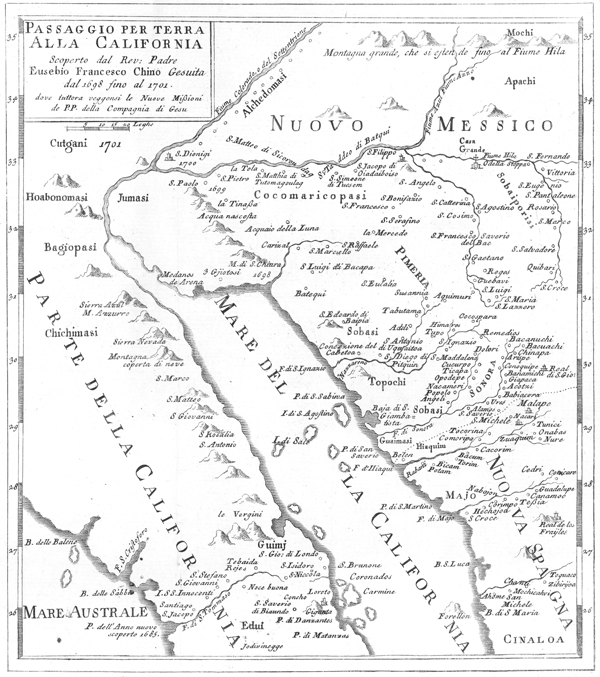|
|
Search for a Southern Route
Kino

The first leg of the first overland route to California was pioneered
by the Jesuit missionary, Father Eusebio Francisco Kino. Arriving in
1687 in the Pimeria Alta--the name then applied to today's southern
Arizona and northern Sonora--to minister to Indians on New Spain's
northern frontier, Kino's spiritual devotion was matched by his zeal
for discovery.
Of all the pioneers who trekked southwestern trails from the
sixteenth through the nineteenth century, Kino is most deserving of
the title of pathfinder. On his numerous trips throughout present-day
northern Sonora and southern Arizona, he seldom had any military
escort and generally traveled with only a few Indian companions
who seem usually to have been servants rather than guides. It is
obvious, however, that the padre often followed Indian trails and was
assisted by local Indians during his journeys.
In the early years of his ministry, Kino devoted his energies to
building missions and otherwise extending the influence of the
church within the boundaries of present-day Sonora. But in the year
1699, while on an expedition to the Gila River, Kino was given some
blue shells that changed all that. Theshells were similar to some he
had seen on the Pacific coast side of Baja California in 1685. He had
never seen them elsewhere. Kino reasoned that the shells must have
come overland from the coast. Though he never ceased his quest for
souls, from that year the friar occupied himself most fervently in the
search for a land route to California.
Kino saw good reason for opening a road between Sonora and
California. The Manila Galleon--the trade ship which traveled
annually from Mexico to the Philippine Islands and back--could be
provisioned from the Pimeria, and the upper frontier could
participate in the trade with the Galleon. A newly-prosperous
Pimeria then would be able to expand its commerce with the interior
of Mexico and open trade with New Mexico and perhaps even
beyond to New France.
According to his own count, Kino made fourteen expeditions to'
prove that there was a land passage to California and, further, that
Lower California was a peninsula rather than an island. Indeed, he
crossed the Colorado River to the California side in the course of his
explorations. Kino eventually wrote of his findings: "I discovered the
land-passage... at the confluence of the Rio Grande de Gila and the
abundant waters of the Rio Colorado." As to that land lying west of
the Colorado River, Kino added : "I assign the name of Upper
California." Kino's dream of an overland route to California, lapsed
with his death in 1711.
Previous - Next
|
|